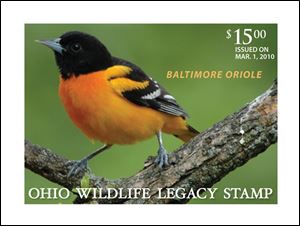
Wildlife division hoping oriole stamp raises funds
3/7/2010
The Ohio Division of Wildlife hopes all who want to support wildlife, not just hunters, trappers, and fisherman, will buy the new Baltimore oriole stamp.
If you like the Baltimore oriole, and who doesn't, then you are going to love the inaugural Ohio wildlife legacy stamp.
Officially launched last Monday by the Ohio Division of Wildlife, the stamp features with the popular, eye-catching orange-and-black songbird. It is aimed at wildlife lovers, be they photographers, birders, hikers, campers, naturalists - or those historic supporters of traditional fish and game programs, hunters, trappers, and fishermen.
"This [stamp] is a mechanism to provide more funding for people who may not hunt, fish, or trap but who support wildlife and wildlife conservation," stated Kendra Wecker, wildlife diversity coordinator for the wildlife division.
Wecker said the first run was for 5,000 legacy stamps. "We're hoping to sell all those and order more."
She noted that hunters, anglers, and trappers, while not required to purchase legacy stamps, are welcome to buy and collect them as well. In fact, hunters and anglers can buy a legacy stamp online by checking a box when purchasing hunting and fishing licenses and permits.
The oriole was selected for the first stamp and next year's likely will feature a dragonfly.
Sales certainly would be a big boost to the few other relatively minor opportunities to support wildlife outside traditional license sales. Those include the state income tax refund checkoffs and sales of cardinal and bald eagle license plates.
Plenty has been done in the last century for fish and game species, thanks to the considerable willingness of hunters and anglers to pay the way with untold billions of dollars in license and permit fees, excise taxes on gear, outright donations, and much, much more.
But traditionally efforts to benefit species other than those on the game and fish lists not surprisingly have occurred more by default than by design - as in meadowlarks and dickcissels benefitting from pheasant and quail habitat projects. Enter the concept of wildlife diversity.
A year ago the state wildlife division announced creation of the Ohio Wildlife Legacy Stamp, calling it "a new tool for Ohioans to help conserve, enhance, and restore native wildlife and its habitat."
In its announcement of the stamp program a year ago, the wildlife division noted that restoration of such native species as river otters and bald eagles, as well as acquisition of critical habitats and development of educational materials, had fallen mainly on the shoulders of license-buying and excise-taxed hunters and anglers.
But the wildlife division noted that competition for these dollars is growing and there simply isn't enough funding to meet all the needs of Ohio's wildlife.
An excellent description of the stamp and the programs it aims to support can be viewed online at wildohiostamp.com. The site includes stamp purchase details.
Initial enthusiasm for the stamp and the financial boost it could mean for nongame wildlife programs is high. For example, Doug Bensman, the Ohio regional wildlife biologist for Pheasants Forever and Quail Forever, this week urged that organization's supporters to get behind it.
"Buying this collectible wildlife stamp will show that you support habitat restoration, land purchases, and conservation easements, keeping common species common, endangered and threatened native species, educational products for students and wildlife enthusiasts, wildlife and habitat research projects," Bensman summed.
Wecker said that the wildlife diversity community, including birding and naturalist organizations, also is excited about the stamp. A recent mailing went out to some 800 conservation clubs as well, explaining the stamp program and offering bulk sales, a portion of which would benefit participating clubs.
The critical point behind the stamp is that the future of fish and wildlife programs in America revolves around the concept of wildlife diversity
The February issue of the Journal of Wildlife Management for example, includes a thoughtful commentary connected to wildlife diversity. It urges the reform of the financial, political, and constituency underpinnings of state wildlife agencies.
The idea, the commentary noted, is not to edge out or diminish the role and importance of hunting, fishing, and trapping and their supporters, but rather to expand the envelope, to be broadly inclusive of those who support wildlife causes but do not necessarily choose to hunt, fish, or trap.
The authors call for broad-based funding and apolitical, trustee-based governance of wildlife agencies, multidisciplinary science as the basis of recommendations from professional staff, and involvement of diverse stakeholders and partners in agency decisions. A full reading can be found by online search using the key words of "journal wildlife management 21st century."
In related news, the 2010 Ohio Wildlife Diversity Conference is set for Wednesday in the Aladdin Shrine Center in Columbus.
Wil Herschberger, author of The Songs of Insects, is the keynote speaker for the day-long program, which the wildlife division's Wecker hopes may draw up to 1,000 attendees or more.
The theme for the day's presentations, "It All Makes Sense," sets the tone for discussions about scent, sound, and taste and their effects on wildlife and humans. Conference topics include skunks, the paddlefish caviar market, wild boar, saw-whet owls, and kids and conservation. The new legacy stamp also will receive some attention, according to Wecker.
To register or for other details, visit online at wildohio.com or call 1-800-WILDLIFE.
The first such conference in 1985 drew but 40 participants. So it is clear that with attendance this time expected to crowd 1,000, wildlife diversity is catching on.
Contact Steve Pollick at:
spollick@theblade.com
or 419-724-6068.